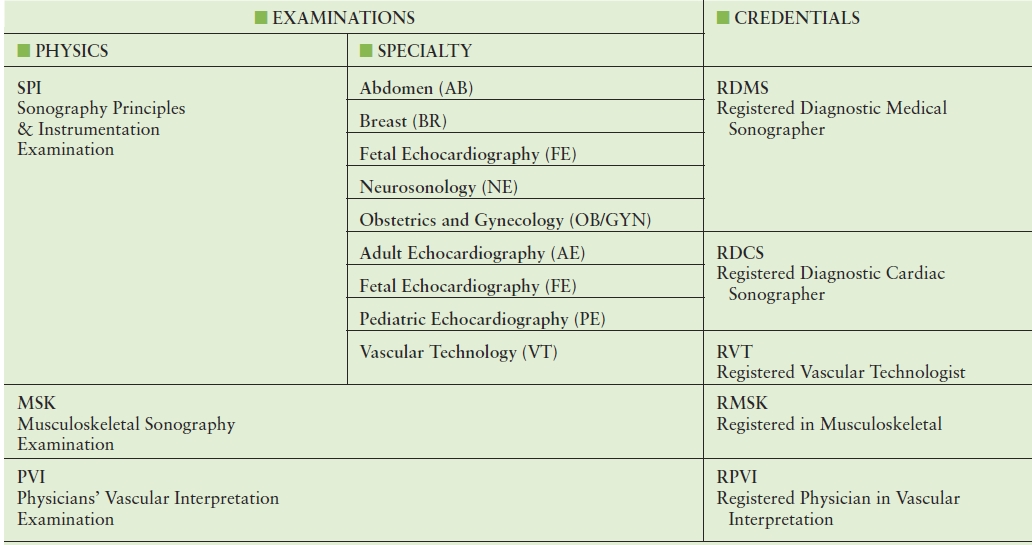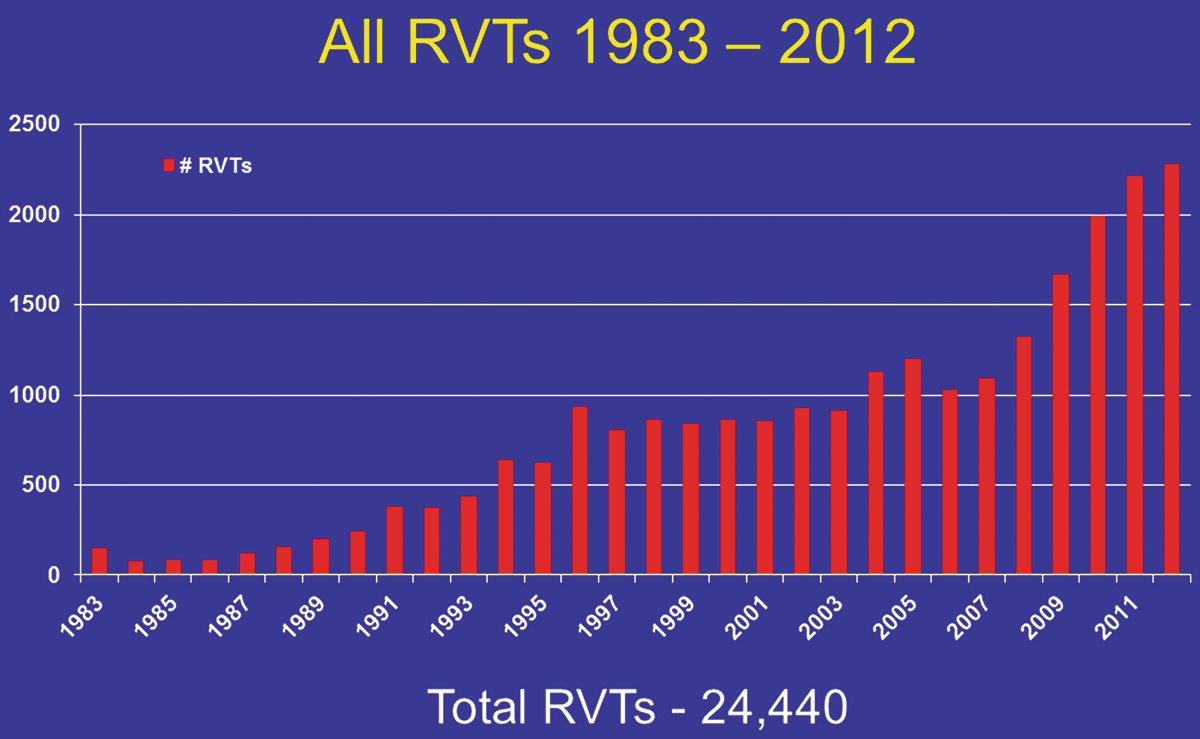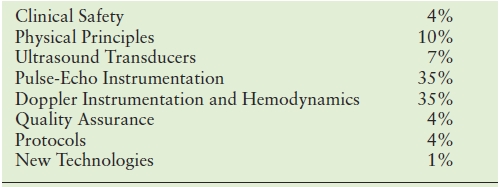THE AMERICAN REGISTRY FOR DIAGNOSTIC MEDICAL SONOGRAPHY
The ARDMS was incorporated in 1975 as an independent nonprofit organization to provide certification examinations in the various specialties of medical sonography. In addition to vascular technology, these now include abdomen, breast, neurosonology, obstetrics and gynecology, musculoskeletal sonography, and adult, pediatric, and fetal echocardiography (Table 3.2). The ARDMS has also developed a credential for physicians who interpret vascular laboratory tests—Registered Physician in Vascular Interpretation (RPVI). Although physicians can be eligible to take the examinations leading to the ARDMS sonography credentials, the RPVI is the first credential created specifically for physicians. As of late in 2013, the ARDMS has certified over 80,000 individuals, including more than 24,000 vascular technologists and about 2000 interpreting physicians. As a member of the National Commission for Certifying Agencies, the ARDMS examinations are required to be “practice based,” that is, they must reflect current practice in diagnostic ultrasound. To make sure that this requirement is met, periodic “job task analysis” surveys are conducted to document the status of the various ultrasound specialties. These surveys are made available online to ARDMS registrants in a particular specialty and cover all aspects of ultrasound practice relevant to that specialty. The results of these surveys determine the topics covered and the content of the questions for the examination.1–3
TABLE 3.2 Sonography Examinations and Credentials Offered by the ARDMS

Both the SPI and a specialty examination are required for the RDMS, RDCS, and RVT credentials. The RMSK and RPVI credentials require a single examination that includes some physics content.
Between 1975 and 1982, the ARDMS offered a certification examination in Peripheral Vascular Doppler. The Registered Vascular Technologist (RVT) examination was first administered in 1983, and through 2012 more than 24,000 individuals have obtained the RVT credential (Fig. 3.1). A survey conducted by the SNIVT in 1982, along with the 1988, 1994, 2000, 2005, and 2009 ARDMS vascular technology task surveys, documents the changes that have occurred in this specialty.

FIGURE 3.1. Annual numbers of individuals obtaining the RVT credential from 1983 through 2012.
The 1982 SNIVT Survey
In 1982, ankle and segmental blood pressures were the most common examination methods for peripheral arterial disease, while continuous-wave Doppler and impedance plethysmography were the most widely used tests for deep vein thrombosis. Testing methods for extracranial carotid artery disease included phonoangiography, periorbital Doppler, and pressure or pulse delay oculoplethysmography. Patients were frequently subjected to multiple tests for a single vascular problem. B-mode or duplex imaging was used by less than 25% of the surveyed technologists and only for the diagnosis of carotid artery disease.1
The 1988 ARDMS Vascular Technology Task Survey
The most striking change in vascular technology between 1982 and 1988 was the growth of duplex scanning as a primary testing method.2 According to the 1988 ARDMS survey, 96% of RVTs used duplex imaging; however, only 24% had access to color-flow instrumentation. The indirect testing methods were still widely used for peripheral arterial and venous disease, although 23% of RVTs were performing duplex scanning of the peripheral arteries and 75% of RVTs reported using duplex scanning for evaluation of lower extremity bypass grafts. Duplex scanning was the predominant technique for extracranial carotid artery testing, with only about one-half of RVTs still performing indirect cerebrovascular testing. Transcranial Doppler was being used by 17% of RVTs.
The 1994 ARDMS Vascular Technology Task Survey
The 1994 ARDMS survey indicated that 93% of RVTs utilized some form of duplex scanning with color-flow imaging.3 While the use of indirect peripheral arterial tests declined slightly, arterial duplex scanning was used by 86% of RVTs. For venous testing, 95% of RVTs used duplex imaging for diagnosis of deep vein thrombosis, and 82% performed duplex saphenous vein mapping. Continuous-wave Doppler was still used by 69% of RVTs, but only about 10% reported using plethysmographic methods for venous disease. The indirect cerebrovascular tests continued to decline, with about 14% of RVTs using oculoplethysmography and 30% performing the periorbital Doppler test. Duplex scanning with color-flow imaging was used by 98% of RVTs for carotid evaluation. The use of transcranial Doppler among RVTs increased only slightly to 20%.
The 2000 ARDMS Vascular Technology Task Survey
In the fall of 1999, the ARDMS conducted its first “online” task survey for vascular technology. Among the responding RVTs, 41% were working in accredited vascular laboratories. It is noteworthy that approximately 90% of RVTs provided preliminary interpretations of examinations to referring physicians. Duplex imaging with color flow was used by 98% of RVTs for one or more applications. About 70% of RVTs measured segmental pressure gradients in the lower extremities, and 88% used duplex imaging to assess the lower extremity arteries. Mesenteric and renal artery duplex scanning were performed by 51% and 63% of RVTs, respectively. About 4% of RVTs reported using impedance plethysmography for lower extremity venous evaluation. For the extracranial carotid evaluation, less than 10% of RVTs still performed periorbital Doppler testing, while only about 2% used any type of oculoplethysmography. Duplex scanning with color-flow imaging was used by 98% of RVTs for carotid testing. The use of transcranial Doppler among RVTs remained around 20%. About 25% of RVTs performed some type of intraoperative monitoring by duplex scanning.
The 2005 ARDMS Vascular Technology Task Survey
The changes in the specialty between 2000 and 2005 were not as striking as were those noted in the prior periods.4 In 2005, approximately 50% of the responding RVTs were working in accredited laboratories. When asked about the specialty of the physician who interpreted their test results, the responses included radiology in 43%, vascular surgery in 29%, and cardiology or vascular medicine in 14%. About 74% of RVTs performed some nonvascular testing, such as general or cardiac ultrasound. As in the 2000 survey, 90% of RVTs provided preliminary interpretations to referring physicians. In 2005, essentially all RVTs used duplex instruments with color-flow imaging, and two-thirds had access to digital image storage. With regard to advanced applications of vascular imaging, 52% performed mesenteric duplex, 69% performed renal duplex, and 66% used duplex scanning for follow-up of endovascular aortic aneurysm repair. In addition, 85% of RVTs used duplex scanning to assess venous valvular incompetence.
The 2009 ARDMS Vascular Technology Task Survey
In late 2009, about 2000 RVTs were invited to complete an online task analysis, and 445 completed the survey for a response rate of 22%. The educational level of respondents was a Master’s degree in 6%, Bachelor’s degree in 31%, and an Associate degree in 28%. An MD degree was reported by 5%. When asked how many years they had been in a vascular technology practice, the response was 20 or more years in 18%, 16 to 20 years in 18%, 11 to 15 years in 18%, 6 to 10 years in 25%, and 0 to 5 years in 21%. Regarding workload, 40% performed up to 50 examinations per month and 29% performed 51 to 100 examinations per month. There were no major changes in the instrumentation used for testing or the types of tests performed between the 2005 and 2009 surveys.
The RVT Credential
Eligibility for the examinations leading to the RVT credential is determined by a set of prerequisites that are based on a candidate’s education and ultrasound experience. These prerequisites are revised periodically to reflect ongoing changes in the field. The ARDMS sonography credentials (Registered Diagnostic Medical Sonographer [RDMS], Registered Diagnostic Cardiac Sonographer [RDCS], and RVT) require passing a physical principles examination and a specialty examination. In 2009, the separate physical principles examinations for the various sonography credentials were replaced by a single Sonography Principles and Instrumentation (SPI) examination (Table 3.2). This change recognizes that the basic principles of ultrasound are common to all the sonography specialties. It also makes it easier for sonographers to obtain multiple credentials, since they do not need to take different physical principles examinations for the RDMS, RDCS, and RVT credentials. The SPI examination consists of approximately 120 questions and must be completed within 2 hours, while there are approximately 170 questions on the Vascular Technology examination that must be completed within 3 hours. ARDMS examinations are administered at testing centers located throughout the United States and Canada, as well as selected locations in Europe, Asia, and South America.
The specific topics covered in each ARDMS examination are based on the results of the job task analysis surveys that are performed every 3 to 5 years. Content outlines list the various topics and can serve as a study guide for those preparing to take the examinations. In 2010, a standard content outline format was adopted for all ARDMS examinations. This new format does not use the familiar major testing areas as main headings for the Vascular Technology examination, but divides the content into general “domains” that include Anatomy and Physiology, Pathology, Patient Care, Integration of Data, Protocols, Physics and Instrumentation, and Treatment. In this format, appropriate topics for each testing area (cerebrovascular, venous, peripheral arterial, and abdominal/visceral) are covered within the individual domains. For example, the Protocols domain constitutes 33% of the Vascular Technology examination and includes many tasks that vascular sonographers do on a daily basis, such as applying standards and guidelines for testing, measurement techniques, and physiologic testing. So although the new content outlines look quite different, this is mainly due to the way the material is organized. Tables 3.3 and 3.4 give the current content outlines for the SPI and Vascular Technology examinations.
TABLE 3.3 Major Headings in the Content Outline for the SPI Examinationa

Percentages refer to the proportion of questions devoted to that content area.
aAs of summer 2013.
Stay updated, free articles. Join our Telegram channel

Full access? Get Clinical Tree


